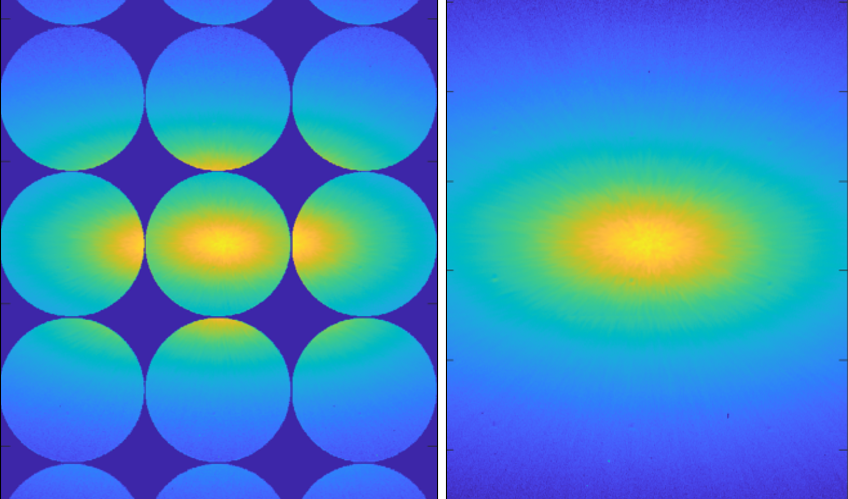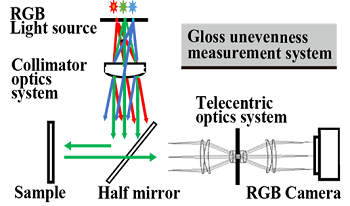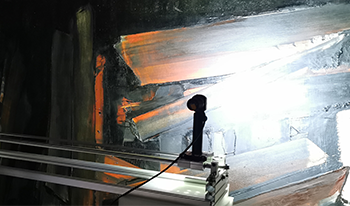
The measurement of specular gloss using a glossmeter is normalized in the ISO 2813 Standard, which is widely used for many industrial applications. In practice, the principle of the measurement relies on using a primary standard that approximates a perfectly polished back glass surface and an optical design where rectangular diaphragms are used for the source and detection apertures. Any deviation in the refractive index or the polishing level of the standard artefact, or in the machining of the rectangular diaphragms ends in measurement uncertainties. To tackle these issues, we propose to calculate the specular gloss from the bidirectional reflectance distribution function (BRDF) measured using a goniospectrophotometer equipped with a conoscopic detection. With such an instrument, no calibration sample is needed anymore, and the geometry of measurement given in the standard can be applied with good accuracy. The method has been implemented and tested on samples of various gloss values.

In this paper, we introduce the analysis for gloss unevenness by using developed multiple directional incident lights optics. Gloss unevenness is strongly related to recognition of material texture. However, it looks different depending on the angles, so it has been difficult to measure quantitatively. The gloss unevenness caused by surface roughness is able to analyze by the distribution of normal on the surface. We have developed the optical system that simultaneously illuminates with light from three different directions, angles, and captures images of gloss unevenness in one shot. We confirmed that the normal distribution of the surface can be estimated by analyzing the image. This proposed method can not only measure the gloss unevenness image, but also estimate the shape of the surface. As an application of this gloss unevenness observation technology, it is also possible to detect of scratches and coating unevenness in industrial quality control.

When one seeks to characterize the appearance of art paint-ings, color is the visual attribute that usually focuses most atten-tion: not only does color predominate in the reading of the pic-torial work, but it is also the attribute that we best know how to evaluate scientifically, thanks to spectrophotometers or imaging systems that have become portable and affordable, and thanks to the CIE color appearance models that allow us to convert the measured physical data into quantified visual values. However, for some modern paintings, the expression of the painter relies at least as much on gloss as on color; Pierre Soulages (1919-2022) is an exemplary case. This complicates considerably the characterization of the appearance of the paintings because the scientific definition of gloss, its link with measurable light quan-tities and the measurement of these light quantities over a whole painting are much less established than for color. This paper re-ports on the knowledge, challenges and difficulties of character-izing the gloss of painted works, by outlining the track of an im-aging system to achieve this.

It can be easily observed that a white support printed with halftone ink layers changes color when coated with a clear layer. The color change can be explained by purely optical phenomena, for example the perception of a different amount of light scattered by the ink-matter interface if the observer is not too far from the specular direction. But color change can be also observed far from the specular direction, especially with halftone colors, where the support has not a homogeneous reflectance at the mesoscopic scale. This is due to subsurface optical phenomena investigated only recently in the case of uniformly colored support. In the present paper, thanks to an original optical model dedicated to halftone colors, we show that this subsurface phenomenon tends to increase the chance for light to meet several ink dots, therefore the chance to be absorbed.

Goniospectrophotometer ConDOR designed by CNAM, France, measures BRDF at very high angular resolution (0.014°), comparable to that of human vision. This is achieved using a very collimated light beam and a dedicated Fourier lens. Interestingly, the BRDF of glossy surfaces measured at this resolution exhibits a granular aspect around the specular direction, like a rapid angular fluctuation, which is not detection noise as it is repeatable between successive measurements on the same sample. Based on our experiments using ConDOR as well as numerical simulations, we claim that this granular aspect comes from an optical effect called speckle, which occurs every time a sufficiently coherent light beam — which is inevitably the case when the incident solid angle is very narrow — strikes a rough surface. First elements of confirmation are given in this paper.

This study focused on suggesting an intelligible index for evaluating gloss degrees of printed images.Psychophysical evaluation of image-clarity was performed for various kinds of paper surfaces. Additionally, cluster analysis was performed for classifying the evaluated values. As results, we found that image-clarity on a printed image and paper can be classified into 4 main categories, and quantitatively clarified that 3 main kinds of paper can be the intelligible index to describe gloss degrees of printed image . Furthermore, extent , in which observers cannot recognize differences of image-clarity, has been shown, and this result is expected to be a useful guide for determining conditions of printers from gloss quality point of view.